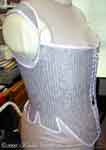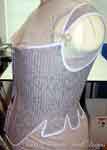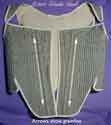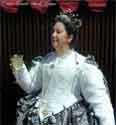Started: December 31, 2008
Finished: April 25, 2009
This was a full garment project, not just the outer layer, but started from the various undergarments that would provide the fashion sillouette of the 1590s, to the gown portions, and ends with the accessories to finish the whole ensemble. I won't go into full details of how they were created, as I recorded much of my progress (with extra photos) in my dress diary blog under various tags, in roughly the order they were made. If you want to read all entries, then click on this tag. The newest entry is at the top of the page.
Effigy Pair of Bodies
 |
 |
 |
 |
 |
 |
The first undergarment is the effigy style pair of bodies, based on the extant garment Queen Elizabeth I's effigy wore, as written by Janet Arnolds in Costume Journal for 2007. It is worn over a smock (which I already had). This is made from silk & cotton blend remnant in a decorative damask pattern. It is boned all around with natural 1/4" reeds. The edges are hand bound in bias-cut china silk. The garment supports the torso & chest, and is shaped into the fashionable conical shape of that era. It is not meant to minimize the waist or emphasis the breasts, but it does give me excellent posture.
Note the last image shows the grainline of the front pieces. This differs from modern garments, which has the grainline along the center front. This image also shows that the center front bust area angles in towards the middle, which provides room for the bust. This makes this pair of bodies more comfortable, and is diferent than many pair of bodies recreations including ones I've made before, which attempt to keep the bust confined in a straight front garment.
The front lacing cord was hand made by me from a 7 -strand braid of embroidery floss in blue & white. An additional brass aglet was later graciously provided & attached by a friend of a friend.
Btw, the pair of bodies is being modeled by my new dress form, which
has been modified, and named "Bessie Blunt".
[view
dress diary entries]
French Farthingale & Petticoat
 |
 |
 |
 |
This is followed by the French farthingale made of silk and more natural reed, which helps provide the 'standing in the middle of a table' look. Honestly. This farthingale is supported underneath by a bolster pillow called a bumroll, to prevent the farthingale from collapsing under the weight of the outer fabrics. It is made from a blue cotton remnant stuffed with polyfill. I don't have a photo of the bumroll. Think of its shape as an overstuffed crescent roll worn on the hips, tied together in front.
The farthingale & bumroll is then covered by a full petticoat, a
simple skirt which in this case is made of black silk at the bottom, attached
to muslin fabric at the upper portion since that part will not be seen.
[view
dress diary entries]
Black & White Gown
 |
 |
 |
 |
The black & white gown is made of multiple parts. The bodice and main sleeves are a silk/linen blend, which was chosen to minimize heat issues. I hand couched silver cord to match the inspiration image. I was not satisfied with the fabric I chose, so I decided to not continue the cording onto the sleeves, or add in the silver paillettes that were planned. The sleeves have millinery wire to help provide support inside.
The skirt and hanging sleeves were the closest to the inspiration design
I could find, within a reasonable price budget. The fabric is cotton/acrylic
blend which is not ideal (that would have been a silk), but after many
months of searching was the best I could find. The skirt is tucked up
around the edge of the farthingale, which allows the bottom of the petticoat
to be seen. It was shaped directly onto the worn farthingale, so it keeps
in place with only a few pins.
[view
dress diary entries]
Accessories
 |
The three accessories I made was a ruff, a hair support, and the pearl headpiece. The ruff (seen at right) was made using the information provided in Janet Arnold's book Patterns of Fashion 4. Unfortunately it was burned during the process to heat set the starch. Don't ever dry your ruff in an oven, either a clothes dryer on a sneaker rack on low, or allow it to air dry. Eventually a replacement will be made.
The hair style of the 1590s is piled rather high in front, which is not something I do normally. So I let my hair grow long, then created a hair support from 2 dish scrubbers wrapped around a simple hair band. My longer hair was split in half, with the back portion put up as a bun, and the front portion rolled onto the hair support. It takes a few tries, but the final effect is similar to the inspiration portrait.
The pearl headpiece was based on an inspiration piece made by one of
the two Tudor Tailor ladies as
seen here. The wires are silvered copper jewelry wires, with various
numbers of fresh water pearls placed on it before the wires are twisted
into shape and position.
[view
dress diary entries]
Home
Creative Blog
Kimiko Small Designs
Joan Silvertoppe's SCA Resumé
Warderobe Accounts
Brodyworke Accounts
Scriptor Arts Folium
Tudor Research
Workshops & Articles
Inspiration Gallery
Largesse
Favorite Links
About Me
Contact Me
http://www.kimiko1.com
Entire website, graphics, and text (unless otherwise stated)
© 2003-2013 Kimiko Small, All Rights Reserved


